Ancient soapmaking dates back nearly 5,000 years to Babylon, where artisans discovered saponification by combining fats with alkaline substances. You'll find that Egyptians, Greeks, and Romans all refined these techniques, adding aromatic herbs and essential oils extracted through distillation. Early soapmakers incorporated local botanicals like lavender and rosemary, while trade routes introduced exotic spices such as cinnamon and cardamom. These fragrant soaps served both practical hygiene and spiritual purposes in ancient societies. The traditional methods reveal much about our ancestors' sophisticated understanding of nature's gifts.
Ancient Soapmaking: Crafting Fragrances Like Our Ancestors
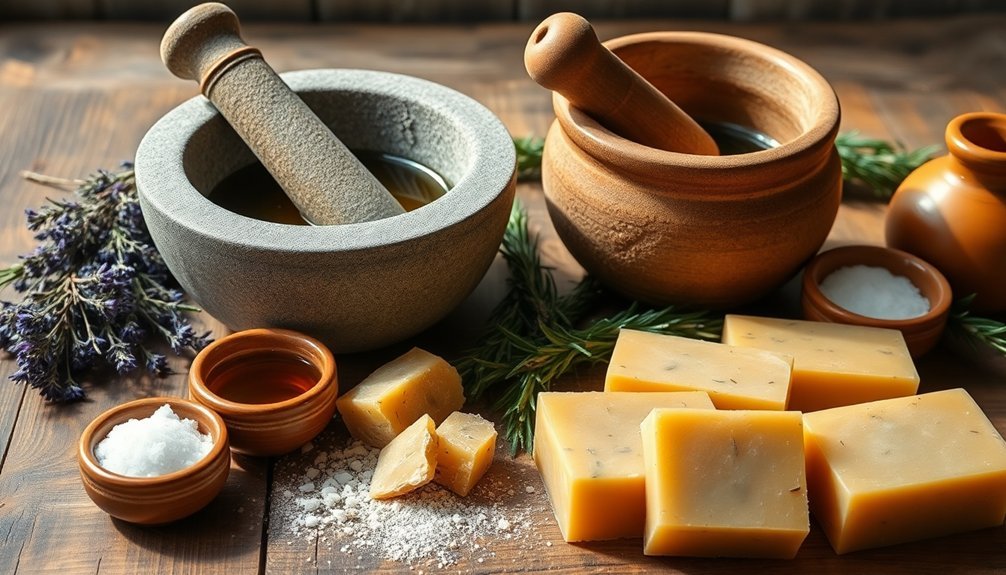
While we enjoy our scented soaps today, ancient soapmaking began nearly 5,000 years ago in Babylon with a simple yet ingenious process. You can trace this craft back to 2800 BCE, when our ancestors discovered saponification—the chemical reaction that occurs when fats mix with alkaline substances like ash or lye.
In Egypt, you'd find soap-like substances created from animal and vegetable oils combined with alkaline salts, used for both hygiene and medicine.
The Greeks and Romans later refined these techniques, incorporating local ingredients and making soap essential for daily cleanliness.
If you'd visited medieval soap workshops, you'd witness the evolution of this ancient craft as artisans experimented with olive oil—an innovation brought back by Crusaders—establishing specialized guilds in cities like Marseille.
The Origins of Scented Soaps in Ancient Civilizations
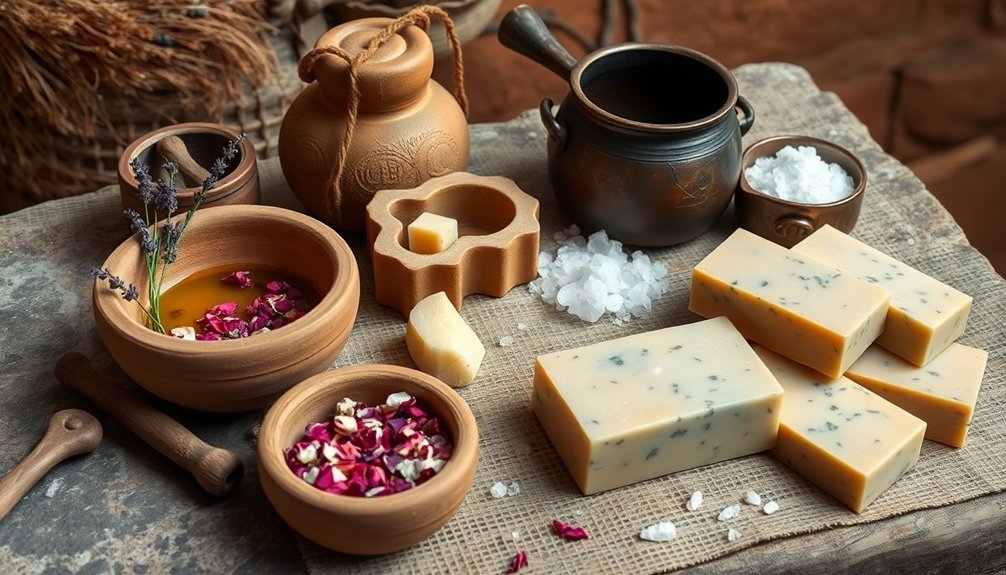
When we explore the origins of scented soaps, we're transported to ancient Babylon around 2800 BCE, where the first fragrant cleansing substances emerged.
These early civilizations combined animal fats with alkaline ashes to create rudimentary cleansers.
The Egyptians elevated this craft by mixing vegetable oils with alkaline salts, incorporating fragrance into their daily hygiene rituals.
They weren't just cleaning—they were creating sensory experiences.
This knowledge eventually reached the Greeks and Romans, who enhanced their soaps with herbs and aromatic oils.
Roman bathhouses became social centers where citizens enjoyed olive oil-based scented soaps during communal bathing.
Pliny the Elder's historical records document these fragrant creations, showing that even thousands of years ago, people understood that cleanliness could be both practical and pleasurable.
Sacred Perfumes: Religious and Ceremonial Soap Fragrances
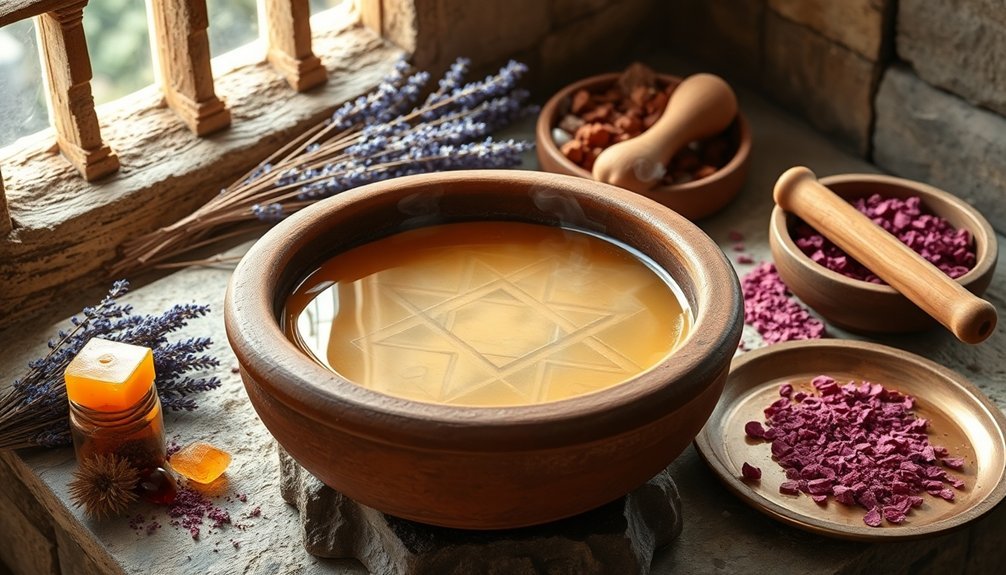
Throughout history, the boundary between cleanliness and godliness was often bridged by fragrance. The ancient Egyptians pioneered this connection with sacred perfumes like Khyphi—a complex blend of cassia and cinnamon used in temple rituals. These weren't merely pleasant scents; they were spiritual mediators.
When crafting your own ceremonial soaps, consider ingredients that echo these ancient practices. Myrrh and frankincense, documented by scholars like Theophrastus and Pliny the Elder, weren't chosen randomly—they possessed both aromatic appeal and preservative properties valued in religious ceremonies.
Greeks and Romans followed suit, believing specific fragrant oils could influence divine entities. Their ceremonial soaps served dual purposes: physical cleansing and spiritual purification, preparing worshippers for sacred encounters.
This tradition reminds us that soapmaking has always transcended mere hygiene.
Plant-Based Aromatic Materials in Historical Soap Making
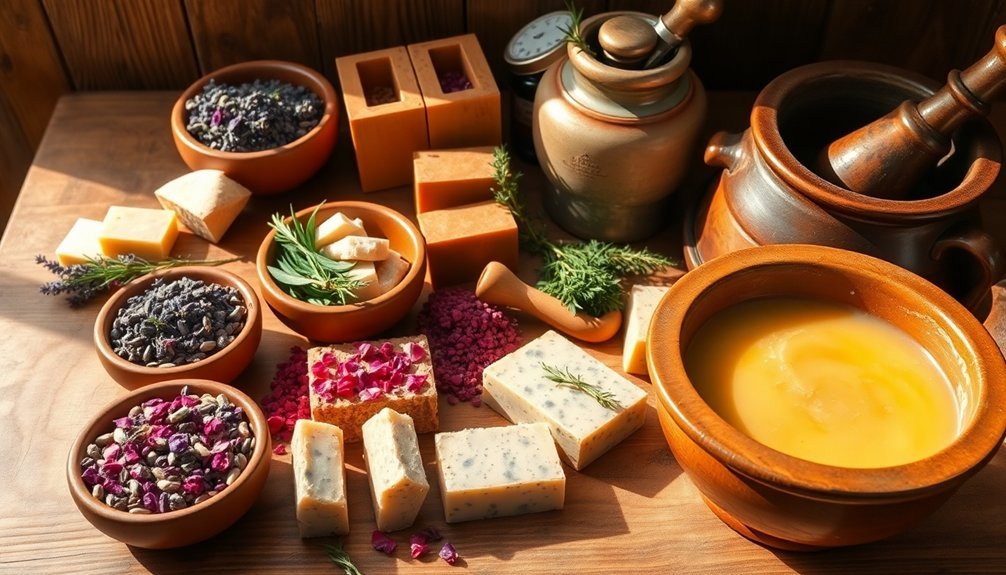
Ancient gardens provided the first perfume palette for soap artisans across civilizations. When you explore the history of soap making, you'll find that plant-based ingredients were at the heart of early fragrance creation.
Egyptians combined myrrh and frankincense oils with animal fats, crafting luxurious cleansing products documented in texts like the Elber Papyrus.
Greek and Roman bathhouses elevated these practices, offering patrons soaps infused with local botanicals that appealed to both senses and skin. Lavender, chamomile, and rosemary weren't just chosen for their pleasant scents—they provided therapeutic benefits as well.
This botanical tradition has endured through millennia. Ancient civilizations' understanding of plant properties continues to inspire today's artisanal soapmakers, who still incorporate essential oils and herbal extracts to create unique, beneficial formulations.
Animal-Derived Scents: Ambergris, Civet, and Musk in Traditional Formulas
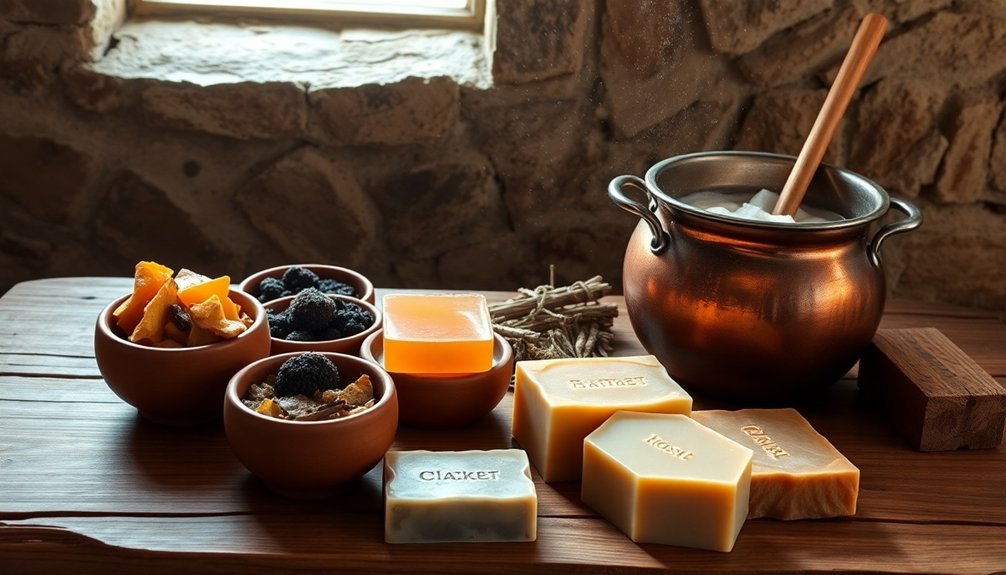
Three rare animal-derived substances formed the backbone of luxury soap fragrances before modern alternatives emerged.
These natural ingredients commanded high prices in ancient markets due to their unique properties and exotic origins.
When crafting soaps like your ancestors, you'd appreciate how these animal scents created complex, long-lasting fragrances:
- Ambergris – A waxy intestinal secretion from sperm whales that served as an excellent fixative, helping preserve other scents.
- Civet – Obtained from African civet cat glands, providing a musky base note that enhanced fragrance longevity.
- Musk – Derived from male musk deer glands, delivering rich, sensual aromas that deepened perfume compositions.
These precious materials were often blended with plant oils and resins, reflecting cultural values and creating aromatic profiles impossible to achieve with botanical ingredients alone.
Distillation Techniques for Essential Oils in Early Soap Perfuming
While animal-derived scents provided luxury base notes, the art of distillation revolutionized early soapmaking by extracting potent essential oils from common plants.
You'll find that ancient civilizations like the Egyptians and Greeks mastered steam and water distillation techniques to separate volatile compounds from herbs and flowers.
These methods preserved delicate fragrances that would otherwise be lost in traditional processing. When you distill botanicals, you're following a tradition that dates back thousands of years—creating concentrated oils that added both scent and medicinal properties to soaps.
During the Renaissance, innovations in distillation equipment expanded the perfumer's palette dramatically.
This knowledge spread across cultures, transforming soapmaking from a purely functional craft into an aromatic art form that captured nature's essence in every bar.
Infusion Methods: Capturing Flower Essences for Fragrant Soaps
When crafting fragrant soaps through infusion methods, you'll need to choose between cold infusions, which preserve delicate floral notes, and hot infusions that speed up the extraction process but may alter some volatile compounds.
Properly drying your plant materials before infusion concentrates their aromatic qualities and prevents unwanted moisture that could lead to mold or spoilage in your infused oils.
Your selection of carrier oils matters greatly, as each brings its own properties to the final product—olive oil creates a mild, conditioning base while coconut oil produces abundant lather and sunflower oil offers lightweight moisturizing benefits.
Cold vs. Hot Infusions
Before diving into the soap-making process itself, you'll need to decide how to capture those delicate flower essences through infusion.
Two primary methods exist: cold and hot infusion.
Cold infusion preserves more natural compounds by steeping botanicals in natural oils at room temperature for several weeks.
Hot infusion accelerates extraction using heat, creating more intense fragrances but potentially altering delicate plant qualities.
Your choice depends on what you value most:
- Cold infusion: Gentle extraction that maintains botanical integrity but requires patience (several weeks)
- Hot infusion: Quicker results with stronger scents but less preservation of subtle plant properties
- Both methods: Allow you to incorporate lavender, chamomile, or calendula's skin-soothing benefits
Add your infused oils during the mixing stage to guarantee your handcrafted soap retains its beautiful fragrance.
Drying Plant Materials
Properly dried plant materials form the foundation of any successful botanical infusion for soapmaking.
When drying lavender, chamomile, or rosemary for your artisanal soaps, you'll need to preserve their aromatic compounds to guarantee vibrant fragrance in your final product.
Air-drying herbs in a well-ventilated, shaded area helps maintain their essential oils, or you can use a dehydrator at low temperatures to accelerate the process while protecting delicate compounds.
Once dried, you'll infuse these botanicals in carrier oils by gently simmering them at low heat, allowing several weeks for the oils to absorb their therapeutic properties.
This patient infusion process not only creates natural fragrances for your soaps but also adds exfoliating textures and skin-nourishing benefits.
Your carefully dried plants will transform ordinary soaps into sensory experiences that connect users to nature's bounty.
Oil Selection Matters
The foundation of successful floral infusions lies in selecting the right carrier oils for your soapmaking process. Your oil selection notably impacts the final soap's properties—olive oil moisturizes while coconut oil creates robust lather and cleansing power.
When crafting infused oils, you're connecting with ancient practices that have produced fragrant cleansing products for centuries. Choose your method based on your timeline:
- Cold infusion—steeps botanicals for 4-6 weeks, extracting deep essences naturally
- Hot infusion—uses heat for immediate extraction when you're short on time
- Botanical selection—lavender, chamomile, and calendula offer both fragrance and skin-soothing benefits
These infused oils don't just enhance your soap's sensory experience; they carry the therapeutic properties of your chosen flowers, creating products that clean, nourish, and delight the senses simultaneously.
Resinous Materials and Their Role in Ancient Soap Scenting
Throughout ancient civilizations, resinous materials served as cornerstone ingredients in early soapmaking, bridging the gap between functional cleansing and aromatic luxury. Egyptians pioneered this practice, incorporating myrrh and frankincense into their soaps for their preservative qualities and therapeutic benefits.
You'll find that myrrh, harvested from Commiphora trees, wasn't just prized for its distinctive scent—it provided natural antiseptic properties that enhanced ancient soapmaking formulations.
Similarly, frankincense offered both fragrant appeal and skin-soothing capabilities, particularly for irritations.
These resinous additions reflect our ancestors' sophisticated understanding of natural ingredients' healing power. They recognized that effective cleansing needn't sacrifice sensory pleasure.
Spice Routes and Their Influence on Soap Perfume Ingredients
Ancient Spice Routes carved pathways for aromatic innovation in soapmaking, connecting disparate civilizations through the exchange of fragrant treasures.
As you craft soaps today, you're continuing traditions established when myrrh and frankincense traveled from the East, fundamentally transforming ancient soapmaking practices.
The Spice Routes' influence on soap perfumes can't be overstated:
- Exotic ingredients like saffron and cardamom became integral to sophisticated soap formulations
- Returning Crusaders sparked European demand for aromatic soaps featuring Eastern scents
- Spices such as clove, cinnamon, and nutmeg redefined medieval fragrance profiles
When you incorporate these aromatic ingredients into your soaps, you're not just creating pleasant scents—you're participating in a rich heritage of cultural exchange that spanned continents and centuries, connecting your craft to ancient artisans.
Cultural Differences in Soap Scenting Across Ancient Societies
You'll notice stark differences in how ancient civilizations scented their soaps, with Mediterranean societies favoring olive-based formulations enhanced with local herbs like lavender and rosemary.
East Asian soap makers incorporated distinctive floral elements such as jasmine and green tea, creating fragrances that reflected their unique botanical heritage.
Mesopotamian and Egyptian artisans developed complex scent profiles using resins like myrrh and frankincense, establishing fragrance traditions that would influence soapmaking for millennia.
Mediterranean Olive Traditions
While many modern soapmakers focus on synthetic fragrances, the ancient Mediterranean world developed sophisticated scenting traditions centered around olive oil.
Greeks and Romans crafted soap with distinct aromatic signatures that reflected their cultural values and available resources.
You'll find these civilizations approached fragrances differently:
- Greek artisans favored natural herb and flower scents like rosemary, thyme, and lavender mixed with their olive oil-based soaps.
- Romans preferred a luxurious blend of olive oil, animal fats, and exotic aromatic resins for their perfumed products.
- Regional variations emerged as Mediterranean trade routes facilitated the exchange of ingredients and techniques.
These ancient civilizations understood that soap served both cleansing and cosmetic purposes, with different formulations available based on social class and individual preferences.
East Asian Flower Infusions
Across the vast silk roads that connected East to West, an entirely different aromatic tradition flourished in Asia's soap-making practices. Ancient Chinese and Japanese artisans mastered the art of flower infusions, incorporating jasmine, chrysanthemum, and plum blossoms into their fragrant soaps.
You'll find that this traditional method wasn't merely about cleanliness—it embodied cultural symbolism and spiritual significance. Japanese soap makers during the Edo period crafted exquisite sakura-infused bars, celebrating the ephemeral beauty of cherry blossoms.
Meanwhile, Chinese artisans enhanced their creations with herbal infusions like ginseng and green tea, balancing aromatic pleasure with skin health benefits.
The ritualistic nature of East Asian soapmaking reflected a profound connection to seasonal changes and natural harmony—where each fragrant bloom carried meaning beyond its scent.
Mesopotamian Scent Formulations
Ancient Mesopotamia, widely recognized as the cradle of civilization, pioneered some of the earliest documented soap-making practices with distinctive aromatic profiles.
You'll find that Babylonian soapmakers combined animal fats or plant oils with alkaline materials like ash, creating cleaning agents that were both practical and fragrant.
When you explore Mesopotamian ancient soapmaking traditions, three elements stand out:
- Religious significance – fragrant soaps played essential roles in spiritual rituals, with scents considered offerings to deities
- Therapeutic blending – aromatic ingredients like myrrh and cedar weren't just for pleasant smells but also for medicinal benefits
- Documentation expertise – clay tablets reveal sophisticated understanding of ingredient properties, showing how oils interacted with other components
Unlike their contemporaries who focused on laundry applications, Mesopotamians crafted these scented formulations primarily for personal hygiene and bathing.
Preservation Methods for Maintaining Fragrance in Handcrafted Soaps
Because fragrance plays a crucial role in the appeal of handcrafted soaps, proper preservation methods are necessary for maintaining their aromatic qualities.
You'll want to select high-quality essential oils specifically formulated for soapmaking to guarantee lasting scent retention.
Incorporating natural antioxidants like vitamin E or rosemary extract helps slow down oil oxidation, preserving both fragrance and soap quality.
Don't underestimate the importance of curing time—allowing your soaps to cure for 4-6 weeks enables the fragrance to fully develop and integrate with the soap base.
Store your finished soaps in a cool, dark place away from sunlight and air exposure.
Consider adding natural fixatives such as clay or specific botanicals to anchor your scent profile, creating a longer-lasting fragrance experience your customers will appreciate.
Tools and Equipment Used for Traditional Soap Perfuming
When perfuming traditional soaps, you'll find clay vessels invaluable for storing and aging fragrance compounds while preserving their aromatic integrity.
Copper distillation equipment allows you to extract essential oils directly from botanicals, creating unique signature scents that commercial producers can't match.
Wooden infusion racks provide the perfect environment for steeping herbs and flowers in carrier oils, imparting their fragrances through a slow, natural process that enhances the final soap's aromatic complexity.
Clay Fragrance Vessels
Throughout history, skilled artisans crafted elaborate clay vessels that played a crucial role in traditional soap perfuming.
These ancient containers weren't just functional tools for soap making—they represented the intersection of utility and artistry, featuring intricate designs that reflected cultural aesthetics while serving practical purposes.
You'll find that these clay vessels revolutionized fragrance development in several ways:
- Allowed soap makers to experiment with different aromatic oil combinations, creating signature regional scents
- Provided ideal storage for perfumes, incense, and scented materials used in the soap making process
- Preserved the potency of botanicals and fragrances, enhancing the final scented product
Archaeological discoveries of these vessels continue to provide valuable insights into how our ancestors approached the delicate art of fragrance creation for their cleansing products.
Copper Distillation Equipment
While clay vessels housed and protected fragrances, copper distillation equipment emerged as the masterful tool for extracting those very scents from nature's bounty.
You'll find these copper stills at the heart of traditional perfuming, where their exceptional thermal conductivity enables precise temperature control during the extraction process.
A typical copper distillation setup includes three essential components: a boiler where plant materials meet steam, a condenser that transforms vapor into liquid, and a collection vessel that captures the precious essential oils.
This ancient technology efficiently separates volatile aromatic compounds from botanicals through steam distillation.
When you craft artisanal soaps using fragrances derived from copper distillation, you're not just creating a product—you're preserving heritage.
The concentrated scents produced through this method deliver authentic fragrance profiles that synthetic alternatives simply can't match.
Wooden Infusion Racks
Pastoral simplicity meets functional elegance in traditional wooden infusion racks, the unsung heroes of aromatic soapmaking.
These slatted shelves create the perfect environment for fragrant botanicals to release their essence into carrier oils over several weeks. You'll appreciate how these sustainable tools help you avoid synthetic additives while creating complex, natural scents.
When you're crafting authentic soaps with these traditional racks, you'll benefit from:
- Enhanced air circulation that maximizes the extraction of essential oils
- The ability to layer multiple botanicals for unique, personalized scent profiles
- A sustainable approach that honors historical soapmaking techniques
Seasonal Scenting: Adapting Fragrances According to Nature's Calendar
Since ancient times, soapmakers have synchronized their craft with nature's rhythm, creating fragrances that mirror the changing seasons.
You'll find this seasonal approach deeply rooted in history, where Egyptian and Roman artisans harvested local botanicals at their peak potency.
In your spring soaps, incorporate lavender and chamomile, while autumn calls for warming cinnamon and clove.
Summer's invigorating citrus oils like orange and lemon contrast with winter's cozy cedarwood and pine.
These natural fragrances don't just scent your soap—they evoke powerful seasonal memories.
Today's artisans continue these ancient traditions, crafting collections that honor nature's calendar.
Frequently Asked Questions
What Did Ancestors Use for Soap?
Your ancestors used animal fats, plant oils, and alkaline substances like ash or lye for soap. They'd mix these ingredients to create cleaning agents for personal hygiene, with variations developing across different cultures.
What Is the Oldest Recipe for Soap?
The oldest soap recipe you'll find comes from ancient Babylon (2800 BCE). It combined water, alkali, and animal fat through saponification. Egyptian recipes followed later, using vegetable oils with alkaline salts instead.
What Was the Old Way of Making Soap?
You'd make traditional soap by combining animal fats or plant oils with alkaline substances like ash or lye. This saponification process, dating back to ancient Babylon around 2800 BC, was labor-intensive but effective.
What Was Soap Made of in Biblical Times?
In biblical times, you'd find soap made from animal fats or vegetable oils mixed with alkaline substances like wood ashes. This created a natural lye that, when combined with fats, produced a basic cleansing product.
In Summary
When you craft fragrances like our ancestors, you're not just making soap—you're preserving history. You'll find that ancient scenting wisdom still works beautifully today. Try incorporating seasonal plants, experiment with traditional preservation techniques, and honor the cultural significance behind each scent. Whether you're using simple herbs or complex blended aromatics, you've joined a tradition that's connected humans through fragrance for thousands of years.

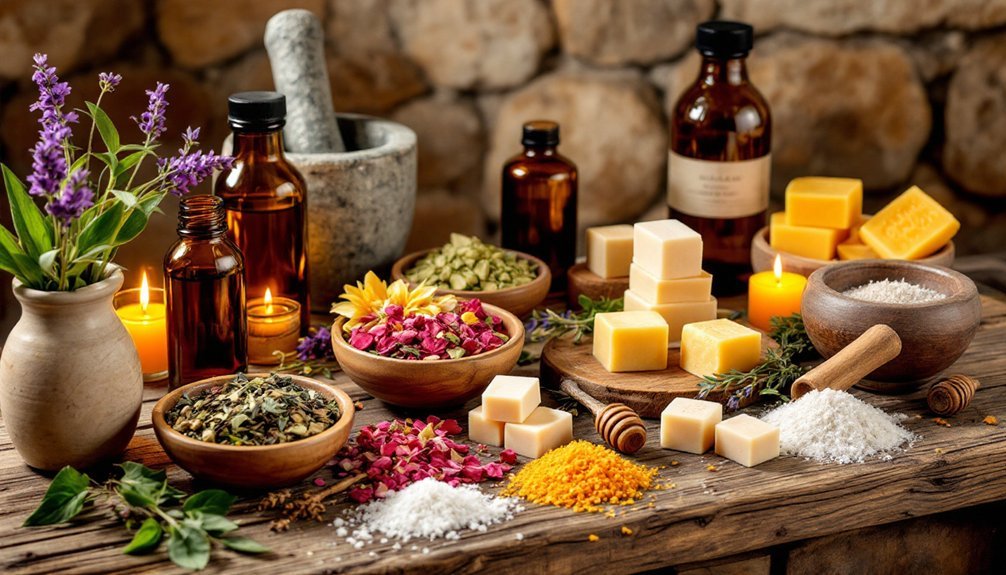



Leave a Reply